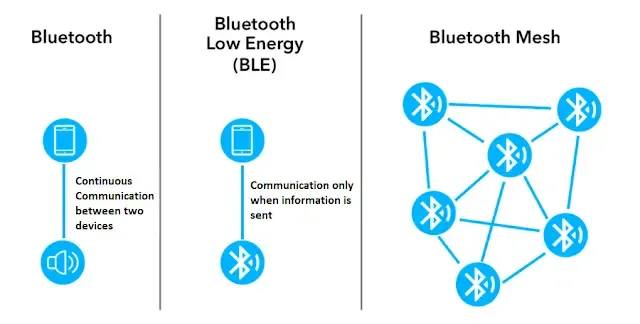1. Introduction
Bluetooth Mesh is a wireless communications technology that allows multiple devices to communicate with each other reliably and securely. It is ideal for smart lighting, as it allows you to create networks of luminaires that can be controlled and automated centrally or decentrally.
2. Historique de Bluetooth Mesh pour éclairage public
2017: Bluetooth Special Interest Group (SIG) publishes the first version of the Bluetooth Mesh protocol, a version designed for industrial and commercial applications and then public lighting.
2018: Bluetooth SIG releases the second version of the Bluetooth Mesh protocol, which brings several improvements in terms of security and great eco-friendliness.
2019: Bluetooth SIG releases the third version of the Bluetooth Mesh protocol, version brings several improvements in energy efficiency and intelligence.
2022: the Bluetooth SIG announced that more than 100 million Bluetooth Mesh luminaires have been installed worldwide.
3. Examples of Bluetooth Mesh street lighting deployments
Stockholm, Sweden (2013): 10,000 Bluetooth Mesh lights were installed in Stockholm city center.
Helsinki, Finland (2014): 10,000 Bluetooth Mesh lights were installed in downtown Helsinki.
London, United Kingdom (2015): 1000 Bluetooth Mesh luminaires were installed in the Westminster district.
Paris, France (2016): 1000 Bluetooth Mesh lights were installed in the Montmartre district.
New York, United States (2017): 1000 Bluetooth Mesh lights were installed in the Times Square district.
4. Different types of Bluetooth
“Standard” Bluetooth was designed to create a short distance connection between two devices only to exchange continuous information: file sharing, listening to music, etc.
Bluetooth Low Energy (BLE), previously called Bluetooth Smart, allows information to be sent between two devices only when necessary, with half the energy consumption of classic Bluetooth. All on a frequency of 2.4 Ghz.
Bluetooth Mesh is a system in which several devices (lights, detectors, etc.) are meshed. They can therefore communicate with each other, which was not possible before. All devices with a version equal to or higher than Bluetooth 4.0 are compatible. This system was designed to be deployed and used for IoT and data transfer between multiple connected devices.
Figure : Different types of Bluetooth
5. How does Bluetooth Mesh work?
6. Advantages of Bluetooth Mesh for lighting
Reliability: Bluetooth Mesh is a very reliable technology, even in low range or high interference conditions. This is because it uses a mesh network, which means messages can be transmitted by multiple devices.
Security: Bluetooth Mesh is a secure technology because it uses advanced encryption techniques to protect transmitted data.
Scalability: Bluetooth Mesh is a scalable technology, which means it can support a large number of devices.
Cost: Bluetooth Mesh is an affordable technology, which allows it to be used in a wide range of applications.
7. Applications of Bluetooth Mesh for lighting
Centralized control: Bluetooth Mesh can be used to control a network of fixtures from a single console. This makes it possible to create personalized lighting scenarios or control lighting remotely.
Automation: Bluetooth Mesh can be used to automate lighting using control and motion detection equipment.
Security: Bluetooth Mesh can be used to improve security or to control lighting.
8. Conclusion
Bluetooth Mesh is a promising technology for smart lighting. It offers many advantages over traditional wireless communications technologies, including increased reliability, enhanced security and scalability.







0 Comments